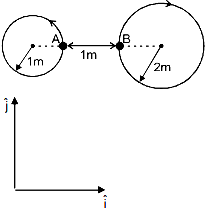Two particles are moving in different circles in same plane with different angular velocities as shown in figure. At t = 0, initial positions of particles A and B are shown by dots on the respective circles. Initial distance between particles is 1m. Particle A move anticlockwise in the first circle whereas B moves clockwise in the second circle. Angle described (rotated) by A and B in time 't' are θA = (π/2)t and θB = πt respectively. Here θ is in radian and t is in second. Radius of each circle is shown in diagram.

If the velocity of both the particles are equal in magnitude through out the motion. The path of 'A' & 'B' are circular as given. Which of the following is/are correct?
(A) They are having equal kinetic energy.
(B) Distance covered by both the particles are same at any instant of time.
(C) Angular velocity of 'B' is twice of 'A'
(D) When particle 'B' reaches its initial position, displacement of both the particles are equal at that instant of time.